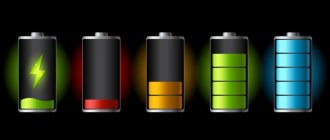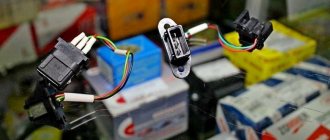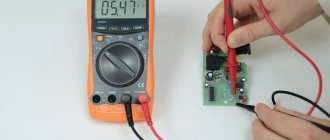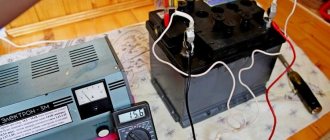AA batteries are used in many modern devices as batteries. Although outwardly these products are indistinguishable from each other, their technical parameters, as well as cost, can vary significantly. To avoid getting into trouble by purchasing a product with a short lifespan, or even one that doesn’t work at all, you should know how to check these elements and be able to do it in practice. This skill will also come in handy when checking batteries accumulated at home - if one of them belongs in a landfill, then others can still serve in devices that do not differ in power. In this article we will figure out how to check a battery with a multimeter, and at what amount of residual charge it can be used in electrical appliances.
Checking the charge without load
To identify completely faulty elements, it is enough to perform a simple check:
- Select the multimeter mode corresponding to measuring the DC voltage value.
- Set the measurement limit to 20V.
- Apply the probes of the device to the contacts of the battery being tested and measure the voltage.
- Take tester readings.
If the voltage shown when checking the battery with a multimeter is more than 1.35V, the battery is in good condition and is suitable for use in any electrical appliance. If the charge of the element is less than this level, but not lower than 1.2V, it can be used in undemanding devices. At a lower charge level, the battery cannot be used and must be disposed of.
To complete the picture, such a check is not enough, since it shows the magnitude of the no-load voltage (EMF).
As a load element, you can use a regular light bulb designed to work in a flashlight. LEDs are not suitable for this because their resistance is too low. The load volume should be from 100 to 200 mA - this is the most common indicator for most modern medium-power electrical products.
However, to reject batteries that are clearly unusable for use, checking with a tester without a load is sufficient. If the device shows less than 1.2V, testing under load is pointless.
General information about the multimeter
This electrical measuring instrument is often called a “tester”. It can be digital or analog.
There are small, portable instruments, and some are larger and are used for continuous measurements.
2 multimeter probes are connected as follows:
- insert a black plug into the socket marked “COM”;
- into the “VΩmA” connector – a red cord.
Purpose
The multimeter measures current, voltage and resistance. Measured parameters and their most common ranges:
- Constant current: 0.2, 20, 200 mA; 10 A.
- Constant voltage: 0.2 mV; 20, 200, 1000 V.
- Variable voltage: 0.2, 750 V.
- Resistance: 0.2 ohm; 2, 20, 200 kOhm; 2 mOhm.
The multimeter measures voltage and current resistance.
The multimeter does not measure alternating current.
Functionality
In everyday life, small portable devices are most often used. Digital instruments are usually called multimeters, and analog instruments are called testers. Portable devices are battery powered. Using this device, you can find a break in the wiring, determine the capacitance of a galvanic cell, find out the load current in the relay, check the electric motor and much more.
The measurement error depends on the capabilities of the device and ranges from 10 to 0.01%:
| Number of digits | Error, % |
| 2,5 | 10 |
| 3,5 | 1 |
| 4,5 | 0,1 |
| 8,5 | 0,01 |
The number of digits is the number of decimal places in the displayed result. The fractional part means that another position will appear if some condition is met. For example, a resolution of 2.5 means that the final value will be displayed on the display with an accuracy of 2 decimal places, and the third will appear if you change to another range.
Checking electric batteries with a multimeter under load
The remaining elements are retested. Let's now figure out how to check the battery capacity under load. To do this you need to proceed as follows:
- Connect the multimeter probes to the contacts of the battery being tested.
- Connect the load element in parallel and wait 30-40 seconds.
- Take the result.
Depending on the readings of the device, the measured elements need to be sorted. Batteries with a remainder of 1.1V or less can be safely scrapped. Products, when tested by the device, showed up to 1.3V, can be used in remote controls. If the element under load shows 1.35V or more, it is fully operational.
Checking a penny battery tester from Aliexpress
A cheap device that is more convenient than a multimeter and is quite suitable as a utilitarian gift.
Why check batteries?
There are three reasons why a battery that is still working may end up in the trash:
1. Only one defective battery in the bundle “died,” which gives the impression that the entire set has “exhausted . This is not uncommon, especially when buying cheap batteries. You insert a set of four into the device, it works for a while, then the batteries seem to run out. But upon inspection, it turns out that in fact only one “died” due to a manufacturing defect, and the rest had exhausted their service life by 15%.
2. The power-hungry device does not completely consume battery energy . There are also cases where batteries are used in a very power-hungry electronic device that may not fully utilize them. A specific example is the Furby toy. It starts to fail when there is still a third of the energy left in the batteries. Accordingly, these batteries can be used in some other place that is not so demanding on the residual resource.
Why is this happening?
As the battery's charge decreases, its voltage decreases. A AA battery with a full charge gives a voltage of about 1.55 V, and a battery whose voltage has dropped to 0.9 V can be considered dead.
This is what the discharge graphs for salt and alkaline (alkaline) batteries look like:
Taken from here.
My observation is that most devices will stop working or perform poorly when the voltage drops to 1.1V.
3. Slightly oxidized contacts give the impression of a dead battery. You take out what appears to be a dead battery, but when you check it turns out that it is still quite working. The reason, most often, lies in slightly oxidized contacts, at which the resistance increases, and accordingly, the voltage and current begin to drop.
Battery tester BT-168D
This is the cheapest device on Aliexpress. The price tag with delivery to the Russian Federation starts from 180 rubles, but with rare luck you can find it for ~130.
Why can’t you get even cheaper voltmeters there? One nuance will emerge with them - the minimum voltage for measurement is 2.5 volts or more (if we are talking about models without an internal power source). At lower voltages they simply do not turn on. Therefore, it is better to immediately pay attention to specialized options.
I have compiled some characteristics of the device into a table, some of which I obtained during its testing:
| Types of batteries tested | - almost all 1.5-volt elements, from “tablets” to “barrels” LR20 — 9-volt “crowns” (6LR61 / 6F22) |
| Minimum voltage to enable 1.5V input | ~0.55 V |
| Minimum voltage to enable 9V input | ~6 V |
| Maximum length of a 1.5-volt cell | 61 mm |
Regarding starting voltages, if the device does not turn on when you connect the battery, then the voltage on it is below 0.55 V for one and a half volt elements or 6 V for Kron.
It measures voltage relatively accurately, but there is a nuance associated with underestimating the actual voltage readings on AA batteries by 0.05 V. Most likely this is due to the fact that the device itself is powered by it and at the time of measurement creates a load that does not seem to adjusted.
But if we ignore the topic of correction, the readings will be quite accurate.
There is a reminder on the back.
In general, I agree with her. According to my long-term observations, a one and a half volt battery can be considered dead if it produces less than 1.1 V. Most electronic devices no longer want to work with such sources, and the LCD screens of all kinds of clocks and thermometers become faded.
One of the shortcomings of the tester is the freely sliding contact tab, which presses the battery. It would be nice to spring it so that when measuring you don’t have to press it with your hands all the time. However, some craftsmen fix this “bug” on their own:
You can find such a tester on Ali, for example, here. And since many people here have full-fledged multimeters in their household, such a “toy” can be a good gift for one of your relatives.
Checking batteries by measuring current
This method is applied to new batteries and allows you to evaluate their power immediately upon purchase. The multimeter should be set to DC current. To measure the charge level on a new battery, proceed as follows:
- Set the battery tester to the maximum measurement limit.
- Take a new element and attach the probes of the device to its contacts.
- After 1-2 seconds, after the current value on the indicator stops increasing, the probes must be removed.
The normal current for a new battery should be 4-6 Amperes. If it is 3-3.9 Amperes, this means that the battery life is reduced, but the element is suitable for use in portable equipment.
Multimeter readings in the range of 1.3-2.9 Amperes indicate that it is better not to use the battery in ordinary household appliances, but it can be installed in devices that consume a small amount of current (for example, television or other remote controls).
If the current value shown by the tester is 0.7-1.1 Amperes, then such an element is capable of operating exclusively in devices with low power consumption, and the quality of the equipment will decrease. It can be used in “remote” systems, but only if there are no better elements at hand.
The process of checking batteries with a multimeter is clearly shown in the video:
Is it possible to charge a regular battery?
Galvanic cells are alkaline (alkaline) and saline. The chemical reactions occurring in them are irreversible. Therefore, the question of how to charge the battery remains unanswered. Some “Kulibins” try to breathe new life into the product using a conventional mains charger, exposing its contacts and applying batteries to the contacts, but such attempts result in strong heating of the element and can result in an explosion, hand burns and other troubles. Although, to be fair, it is worth saying that the battery can sometimes be restored in this way, but no more than 15%, so the game is not worth the candle. You can also heat the battery with a hairdryer, beat it with a hammer, or simply tap it on something hard, but these methods are ineffective and sometimes dangerous.
| Battery structure |
Useful tips
Here are some recommendations regarding the use of batteries and their disposal:
- Do not delay in checking and sorting batteries accumulated at home. If new batteries are unavailable or there are insufficient quantities, you can temporarily use tested ones if necessary.
- Dead batteries in a household appliance do not need to be completely replaced. Typically, their discharge does not occur simultaneously, and the test will identify batteries that can be used further.
- Do not store unusable batteries at home and, especially, do not keep them in the equipment case. Electrolyte often leaks from them, and this leads to damage to nearby things.
- Do not attempt to damage the battery housing in any way - the liquid contained in it (acid or alkali) may contact your skin, causing a chemical burn.
In addition, used batteries should not be thrown into trash bins. The electrolyte they contain is harmful to the environment, so batteries must be disposed of in places specifically designed for this purpose.
What is a battery and what electrical characteristics determine its performance?
The popular name battery is assigned to galvanic cells or chemical current sources that generate electricity to power household appliances and electronic gadgets.
They are usually produced in finger form with dimensions AA or AAA or in the form of tablets.
Functionally, they may or may not have the ability to charge after intended use (batteries). In the first case, the inscription “Rechargeable” is placed on their body.
In the instructions for other models they write that they cannot be charged, that is, they work one-time until they are completely worn out. This must be taken into account, because when they are installed in a charger under voltage, they can explode.
There was such a case in my practice when a neighbor on the top floor damaged her landline phone. She had nickel-cadmium batteries in her tube, which became unusable after a few years.
She replaced them with batteries of the same shape, talked, and placed the handset on the base... she had to buy a new device.
Be careful not to repeat such mistakes.
The performance of a battery is determined by the amount of electrical power that it is capable of delivering to a connected consumer. At the same time, a potential difference is formed at its terminals in the open state - a voltage that, when connected to any resistance, produces an electric current of a certain strength.
It cannot flow indefinitely, but acts only for that period of time for which the energy stored in the chemical current source is sufficient. All of these processes are interconnected, summarized by the term “battery or accumulator capacity” and described by mathematical formulas.
For example, a car battery has a capacity of 60 amp-hours.
This means that at a load current of 1 ampere it should work for 60 hours, and at 60 amperes it should last only an hour.
The same requirement applies to batteries, only their power is much less. Their capacity is marked in milliamp-hours.
The main electrical characteristic of a battery is its capacity . It determines the duration of operation of the chemical current source, that is, its resource.
Its value constantly decreases during operation, and the rate of decrease strongly depends on the connected load.
The results of one of the verification tests of four identical batteries at different consumer currents showed the following results.
In life, we constantly encounter this: the larger the connected load, the faster the chemical current source fails. Therefore, for each electrical device, its own galvanic element is selected according to its power.
2 factors that can damage a battery from the factory before use: you need to know them
These include:
- time;
- freezing.
I will dwell on them in more detail, because in some cases you won’t even have to use a multimeter.
Storage time and service life of a chemical power source
My neighbor in the country bought a wireless mouse for his laptop. She successfully worked for him for six months, and then refused. He came to me with a question.
We looked at the batteries, there are two AAA ones. They have completely exhausted their charge: they need to be replaced. The neighbor asked his friend, who was traveling to the city, to bring him similar ones.
The next day he asks me again: the power supply has been replaced, but the mouse does not work. I removed the AAA from the case: they have the year of manufacture 2013 on them, when it is now the height of summer 2022. The expiration date has long expired.
It is indicated on the packaging (usually 3 years), and the date of manufacture is indicated directly on the body of the galvanic cell.
This is explained simply: it is almost impossible to completely eliminate self-discharge currents. They are taken into account by their expiration date.
Why you need to pay attention to storage conditions
Let's say we bought batteries for my neighbor at a kiosk on the street. In our country, the period of negative temperatures lasts for six months, and in more northern regions it lasts even longer.
During frost, the capacity of any chemical current source is subject to greater self-discharge; it loses its service life before the specified time.
Considering these two factors, I generally do not buy batteries at kiosks and always check their release date, which I advise you to do.
How is the test carried out depending on the type of battery?
Most batteries used in everyday life are cylindrical in shape. They are called “finger” or “little finger”. All of the above methods are applied to them. The contacts of these elements are located on opposite sides.
There are more powerful power sources - flat batteries of the “Krona” type. The poles of these elements are on one side. Their residual voltage when fully charged is 9 V. Sources with this value below 8.7 V are unsuitable.
Round coin cell batteries have the flat side that is negatively charged and the convex side that is positive. In this case, only current can be measured. For a fully charged battery it should be within 4–6 A.
Universal tester BT-768
The complex and angular shape of the contact pad of this tester allows it to work with batteries and accumulators of any size and voltage up to 9 volts - you just need to choose the appropriate niche. Voltage values are displayed using a scale on an elongated electronic screen. For reference, 3 stripes are applied parallel to it, consisting of red, yellow and green sectors. The device runs on a single AAA battery, to install which you need to remove the cover located on the front side.
$4.59 | Buy
Top
Tester in keychain format
The very compact body structure of the BC-06 model allows it to be used as a keychain and worn on a chain along with keys. There is only one contact pad, and therefore the voltage can only be measured on button cell batteries, for example LR44. Despite its modest dimensions, the creators of the device managed to equip it with an LCD screen and percentage markers to determine the suitability of elements for further use. The case also has a hidden compartment for storing batteries. It is accessible by sliding the cover on the back wall of the device.
$6.96 | Buy
Top











